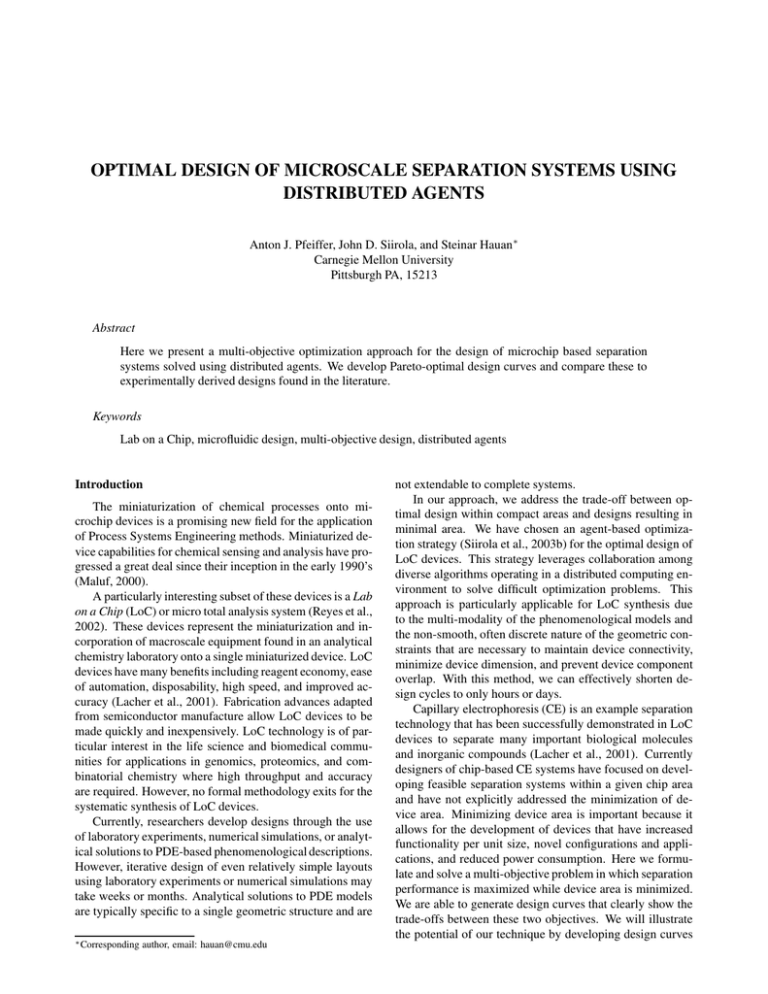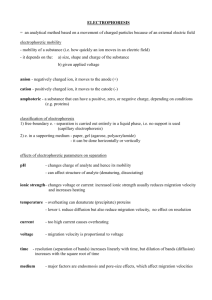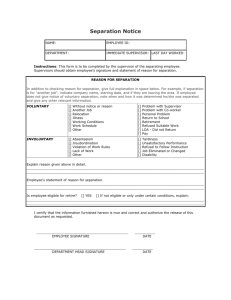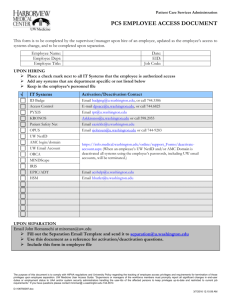OPTIMAL DESIGN OF MICROSCALE SEPARATION SYSTEMS USING DISTRIBUTED AGENTS
advertisement

OPTIMAL DESIGN OF MICROSCALE SEPARATION SYSTEMS USING DISTRIBUTED AGENTS Anton J. Pfeiffer, John D. Siirola, and Steinar Hauan∗ Carnegie Mellon University Pittsburgh PA, 15213 Abstract Here we present a multi-objective optimization approach for the design of microchip based separation systems solved using distributed agents. We develop Pareto-optimal design curves and compare these to experimentally derived designs found in the literature. Keywords Lab on a Chip, microfluidic design, multi-objective design, distributed agents Introduction The miniaturization of chemical processes onto microchip devices is a promising new field for the application of Process Systems Engineering methods. Miniaturized device capabilities for chemical sensing and analysis have progressed a great deal since their inception in the early 1990’s (Maluf, 2000). A particularly interesting subset of these devices is a Lab on a Chip (LoC) or micro total analysis system (Reyes et al., 2002). These devices represent the miniaturization and incorporation of macroscale equipment found in an analytical chemistry laboratory onto a single miniaturized device. LoC devices have many benefits including reagent economy, ease of automation, disposability, high speed, and improved accuracy (Lacher et al., 2001). Fabrication advances adapted from semiconductor manufacture allow LoC devices to be made quickly and inexpensively. LoC technology is of particular interest in the life science and biomedical communities for applications in genomics, proteomics, and combinatorial chemistry where high throughput and accuracy are required. However, no formal methodology exits for the systematic synthesis of LoC devices. Currently, researchers develop designs through the use of laboratory experiments, numerical simulations, or analytical solutions to PDE-based phenomenological descriptions. However, iterative design of even relatively simple layouts using laboratory experiments or numerical simulations may take weeks or months. Analytical solutions to PDE models are typically specific to a single geometric structure and are ∗ Corresponding author, email: hauan@cmu.edu not extendable to complete systems. In our approach, we address the trade-off between optimal design within compact areas and designs resulting in minimal area. We have chosen an agent-based optimization strategy (Siirola et al., 2003b) for the optimal design of LoC devices. This strategy leverages collaboration among diverse algorithms operating in a distributed computing environment to solve difficult optimization problems. This approach is particularly applicable for LoC synthesis due to the multi-modality of the phenomenological models and the non-smooth, often discrete nature of the geometric constraints that are necessary to maintain device connectivity, minimize device dimension, and prevent device component overlap. With this method, we can effectively shorten design cycles to only hours or days. Capillary electrophoresis (CE) is an example separation technology that has been successfully demonstrated in LoC devices to separate many important biological molecules and inorganic compounds (Lacher et al., 2001). Currently designers of chip-based CE systems have focused on developing feasible separation systems within a given chip area and have not explicitly addressed the minimization of device area. Minimizing device area is important because it allows for the development of devices that have increased functionality per unit size, novel configurations and applications, and reduced power consumption. Here we formulate and solve a multi-objective problem in which separation performance is maximized while device area is minimized. We are able to generate design curves that clearly show the trade-offs between these two objectives. We will illustrate the potential of our technique by developing design curves for a common chip-based CE system found in the literature. Background and Theory Electrophoretic separation occurs because of the differential transport of charged species in the presence of an electric field. As an analyte mixture travels through an electrophoretic channel, the species within the mixture separate into bands according to their electrophoretic mobilities. All the while this separation is occurring, the species bands are broadening or dispersing due to factors such as diffusion, geometry, Joule heating, adsorption, and electro migration (Gas and Kenndler, 2000). A performance metric that represents the ratio of the distance between the centers of two adjacent bands to the amount they have dispersed is termed resolution (R). Another common separation performance metric is plate number (N). These metrics indicate better performance as they increase and are not independent (N ∝ R). In traditional CE, when an increase in separation performance is required, the separation channel is made longer. However, long channels can only be made to fit on a microchip by adding turns to the design, which results in a phenomena called turn induced dispersion. The amount of turn induced dispersion depends on the radius of curvature and the flow regime of species within the turn (Culbertson et al., 1998). Turn induced dispersion results from differences in the velocity and electric fields that particles within the band experience from the inner radius to the outer radius of a turn. Furthermore, turns influence the downstream dispersion of species bands by skewing their concentration distribution. The topology of a design, or interconnectivity of channel sections, can be shown to have a significant impact on the performance of a design (Pfeiffer et al., 2003). Two common topologies found in the literature are the serpentine (Jacobson et al., 1994) and spiral (Culbertson et al., 2000) topologies. We will focus on the serpentine topology as it represents a more difficult layout optimization problem and compare the results of our methods to an experimentally derived serpentine design. Design Methodology The goal of this work is to create a method for obtaining a set of Pareto-optimal designs that allow a designer to choose the best topology and operating conditions for a particular application. Our methodology consists of a simulation engine for microchip-based CE, a multi-objective problem formulation that addresses both minimum device area and maximum separation performance, and an agent based optimization strategy to simultaneously determine optimal device layout and operating conditions. With this approach, we are able to develop Pareto-optimal design curves in a matter of hours. Simulation Engine The interactions between channel geometry, topology, and system performance require an efficient and physically accurate means of evaluating alternative designs. We have done this through the creation of a simulation engine for chip based electrophoretic separation systems. The simulation engine can be used to quickly evaluate a specific channel topology with given operating conditions and species physical properties. The concept behind the channel simulation engine is that any channel system can be decomposed into a set of component pieces or sections. Each of these sections contains an algebraic model combined with logic that captures how bands travel and disperse within that section. The phenomenological models used are highly accurate algebraic reduced order component models (Wang et al., 2003). At present, we divide channel systems into straight sections, turns, injectors and detectors. An electrophoretic channel system can be simulated by piecing the channel sections together to produce the desired channel topology. We are currently able to construct the vast majority of the topologies in the literature. [∆X, ∆Y, R, N ] = SIM U LAT OR(L, V, types) (1) Equation 1 is a simplified representation of the simulator which shows the information relevant to the current problem. The simulator takes in a vector of channel lengths, L, the operating voltage, V, and a string containing the channel section types (i.e. turns, straights, detector etc.). Additionally, the simulation has information about species and buffer properties and channel geometry. The vector of channel lengths and the section types define the system topology. This information, along with the operating voltage and system physical properties is used to determine the objectives of interest; device dimensions, ∆X and ∆Y , a combinatoric matrix of resolutions, R, and the vector of plate numbers, N. The calculation of device dimensions is a topic that requires some attention as this calculation has the potential to hinder gradient based optimization. The ∆X and ∆Y dimensions of a design represent the minimum rectangular bounding box for that design. Depending on the perturbations produced by a particular gradient based optimizer, sections may or may not contribute to a change in the overall design dimensions. Consequently, the gradient of device area is discontinuous. However, our agent system is not unduly hindered by this problem. Formulation The design problem can be represented as the following non-linear program (NLP): min Areai = ∆X · ∆Y s.t. ∀i = N S L . . . N S U (2) Rj,k ≥ Rspec ∀ j, k = 1... N C (3) Nj ≥ Nspec ∆Lj,k ≥ (P SD) ∀ j = 1... N C ∀ j, k = 1... N C (4) (5) ∆X ≤ ∆Xspec ∆Y ≤ ∆Yspec (6) (7) w ≤ Ls ≤ ∆Xspec π∆Yspec π · w · (T R) ≤ Lt ≤ 2 (8) (9) (10) For a given topology and number of channel sections, j, between the upper and lower bounds on section number ([N S L , N S U ]) the area is minimized subject to constraints on resolution, peak separation distance, and plate number as well as constraints on the available area for design (∆X and ∆Y ). The design variables are also bounded (Eq. 8-10) to be physically reasonable values. To study the relationship between design area and optimal separation, we reformulate the single-objective NLP into a multi-objective problem by converting the constraint on either resolution or plate number (Eq. 3 and 4, respectively) into a second optimization objective (Eq. 12). min F (x, P ) = ∆X · ∆Y m X 2 min (0, ci (x)) +P · 2 1.5 1 0.5 0 0 10 NLP Solutions Agent Solution 0.5 1 1.5 Area (µm2) (11) 0 (12) −2000 Agent Based Optimization Multi-agent systems are an emerging computing paradigm wherein multiple independent and autonomous software entities, termed agents, interact through a common environment in either a competitive or cooperative manner. Theory and experience suggest that agent systems can effectively integrate heterogeneous algorithms into a single, cohesive system that can operate effectively on a distributed platform. Further, in addition to being scale-efficient, agent systems have been shown (Siirola et al., 2003a) to exhibit synergistic properties; that is, the system as a whole can outperform the sum of its parts. In this application, our agent system is composed of a set of 8 single-objective optimization algorithms (4 working on each objective), 6 multi-objective optimization algorithms, 1 heuristic algorithm, and 4 meta-algorithms. The algorithms interact by sharing intermediate and final solutions to the problem through a central shared memory of problem solutions. Whereas the optimization and heuristic algorithms attempt to directly solve the problem by generating new solutions, the meta-algorithms work on the agent system itself by managing the shared memory system and the computational resource allocation policies. Individual agents operate autonomously, and multiple instances of any agent may be executing at any point in time. The agent ∆Y (µm) The current library of optimization agents can not explicitly model constraints other than simple bounds on decision variables. Consequently, the violation of the constraints (Eq. 5-7) are added to the design area as a penalty term (Eq. 11). At the solution, F is very nearly the area of the design and the discrepancy can be reduced by choosing a larger value of P . 2.5 7 x 10 Figure 1. Comparison of Pareto fronts from Agent system and NLP iteration (17 section serpentine) 7mm i=1 R(x) ← SIMULATOR(x, types) or min N (x) ← SIMULATOR(x, types) 2 −4000 Flow 8.1mm 0 ≤ V ≤ Vmax Resolution bounds −6000 −8000 −10000 0 2000 4000 6000 ∆X (µm) 8000 Figure 2. Schematic of Serpentine by Jacobson et al. (1994) system ran using 32 processors on our in-house distributed cluster. We validated the agent system on a 17-section serpentine topology. Figure 1 shows that the resulting Pareto surface agrees well with an approximate Pareto front formed by 10 single solutions to the original NLP. Further, the agent system was able to produce a substantially more complete surface in an equivalent amount of time. Serpentine Design Study Jacobson et al. (1994) present a 41 section serpentine design that fits within a 1cm x 1cm area (Fig. 2). We are not considering the 90o turns at the beginning and end of the design in our study. The chemical species to be separated are the standard dyes rhodamine B and sulforhodamine (SHA) within a sodium tetraborate mobile phase. Species’ physical properties were derived from results presented in the article. Table 1 lists some of the important design features and data. Figure 3 shows the design curve of area versus plate Table 1. Serpentine Design Data (extracted from Jacobson et al. (1994)) Parameter Values Actual Design Area 57mm2 (7.0mm × 8.1mm) Total Separation Length 165mm Channel Width 90µm Channel Depth 10µm Applied Electric Field 170V cm−1 Applied Voltage (over 165mm) 2.8kV Maximum Available Voltage 4.4kV Number of Plates (@165mm) NRB = 38100 NSHA = 29000 for a given topology. In the future, we will investigate the formulation of variable, hybrid and integrated system topologies including multiple systems on a single chip. We will also investigate the incorporation of the world to chip interface, mixing, and reaction. To handle this new challenge, the agent system will be improved to include explicit constraints on variables and the ability to concurrently solve multiple formulations of the same problem. These improvements will enable faster convergence of individual agents, the possibility of mixed integer formulations, and the incorporation of additional heuristic agents. Acknowledgments This research is sponsored by the Defense Advanced Research Projects Agency (DARPA) under contract number F30602-01-2-0587, Air Products and Chemicals Graduate Fellowship, and NSF grants CTS-0312771 and CTS0094407. The authors would like to thank members of the SYNBIOSYS group at Carnegie Mellon, especially James F. Hoburg, Qiao Lin, Tamal Mukherjee, Yi Wang, and Ryan S. Magargle for their input. 4 5 x 10 region 2 1 ion 3 Experiment reg Plate Number 4 2 References 1 0 0 Optimal Designs 2 4 6 Area (µm2) 8 10 7 x 10 Figure 3. Pareto front for 41 section serpentine design number for SHA generated by the agent system using the specifications in Table 1. The asterisk (*) represents the experimental design generated by Jacobson et al. (1994). We have generated over 5500 designs in under 24 hours that span the full feasible range of areas and corresponding plate numbers. From Fig. 3 it is evident that the design could be reduced to about 30mm2 while still maintaining a plate number greater than or equal to the experimental design. An interesting feature of both Fig. 1 and 3 is the significant change in slope between region 1 and region 2 of the curve. This change takes place because of a shift in the ratio of total length in straight sections to total length in turns. In region 1, area increases due to an increase in straight section length alone while all turns are maintained at their minimum radius. In region 2, turn length increases until the entire alloted design area is filled. Conclusion We currently have the ability to produce Pareto-optimal design curves for serpentine and spiral topologies in only a matter of hours. This allows us to fully and efficiently explore the trade-offs between the conflicting goals of separation performance and device area. Our method produces a range of designs and the appropriate operating conditions Culbertson, C., Jacobson, S., Ramsey, M., September 1998. Dispersion sources for compact geometries on microchips. Anal.Chem. 70, 3781–3789. Culbertson, C., Jacobson, S., Ramsey, M., December 2000. Microchip devices for high-efficiency separations. Anal.Chem. 72, 5814–5819. Gas, B., Kenndler, E., 2000. Dispersive phenomena in electromigration separation methods. Electrophoresis . Jacobson, S., Hergenroder, R., Koutny, L., Warmack, R., Ramsey, J., April 1994. Effects of injection schemes and column geometry on the performance of microchip electrophoresis devices. Anal.Chem. 66, 1107–1113. Lacher, N., Garrison, K., Martin, R., Lunte, S., 2001. Microchip capillary electrophoresis / electrochemistry. Electrophoresis 22, 2526–2536. Maluf, M., 2000. An Introduction to Microelectromehcanical Systems Engineering. Artech House, Inc. Pfeiffer, A., Mukherjee, T., Hauan, S., 2003. Topology trade-offs in the synthesis of chip-based electrophoretic separation systems. In: Proceedings of NanoTech 2003 (MSM ’03). pp. 250–253. Reyes, D., Lossifidis, D., Auroux, A., Manz, A., June 2002. Micro Total Analysis Systems. 1 introduction, theory, and technology. Anal.Chem. 74, 2623–2634. Siirola, J., Hauan, S., Westerberg, A., 2003a. Computing pareto fronts using distributed agents. In: Process Systems Engineering 2003. Vol. 15A of Computer-Aided Chemical Engineering. Elsevier, pp. 334–339. Siirola, J., Hauan, S., Westerberg, A., 2003b. Toward agentbased process systems engineering: proposed framework and application to non-convex optimization. Comp.Chem.Engng. 27 (12), 1801–1811. Wang, Y., Lin, Q., Mukherjee, T., 2003. Analytical dispersion models for efficient simulation of complex microchip electrophoresis systems. In: Proceeding of MicroTAS. pp. 135–138.









